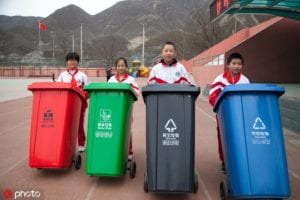Sortinator
After discussing our six project ideas with my project partner, we decided on one I called the sortinator. After further discussion together about the technicalities of the project, we drastically changed the concept of the game and how we want to make it, but kept the overarching goal. Indeed, the original idea is based on the fact that recently China implied a sorting system for the trash, which I realised is confusing for many people, considering the four trashes at school. The purpose of the interactive project is to teach to everyone who participates, no matter the age, how to sort out the trash in China based on the four trash cans. It would tackle a situation that is current and in everyone’s daily lives here in Shanghai as it is a recurring problem around the school and dorms as we have received many emails about our difficulties to sort the trash correctly.
The original game idea from the project proposals included four platforms made of cardboard with the shapes from the trash cans around the school (two circle and two rectangle) incrusted on the cardboard. In front of the participant there would be six elements and when a picture of one of them shows up on the screen, they’d have to put the element on the correct platform under time constraints. However, though the concept of the game is interactive and works theoretically, practically it is a different situation. The sensors that we would have to use are weight sensors in order for the computer to differentiate which element is put on which platform which are unavailable at school, and having only a few components to sort is very limiting for the game and not too hard. My project partner came up with a whole different game which would involved coins just like an arcade game that we would but in the correct box (representing the trash), and we thought of a system so that if you got one wrong then the boxes would tip over and the coins would fall back down to the player. However, we again ran into multiple issues regarding the lack of sensors that we’d want to use and the practicality of where to put them so that the boxes tipping over to release the coins would not affect the sensor wires and the whole circuit.
Our final and for now most practical idea that we came up with is to have four trash cans similar to the ones found on the streets or at the dorms with the lids on , that we would 3D print in smaller versions (as seen on the picture below). We would put a light sensor in the four trashcans so that when an image pops up on the screen, the participant has to open the lid of the trash can which it would go in. Upon the light entering in the trash can, the sensor would detect wether it is the right trashcan or not that is opened. If the light is in the correct on, then the image border would light up green and in order to get another picture, the participant has to put the lid of the bin back down in order to get another picture.

http://global.chinadaily.com.cn/a/201907/20/WS5d326f77a310d830564000c0.html )
This game would be under time constraints and the aim would have to get ten done in the amount of time set and the pictures could be randomly put amongst thirty (so that not everyone has the same pictures). In order to make the time constraint interactive we would design on processing a ticking time bomb where the bomb is the earth (as shown in the image). This would send the message that if you don’t get the ten objects in the right trash on time, then the earth dies.

The significance of this project is quite straightforward: teach about recycling in an entertaining and competitive way while promoting the idea that the earth dies a little each time someone does not recycle. This successfully targets my interpretation of interaction as there is a clear communication between the participant and the bin they choose to put the trash in and the computer. The physicality of the movement of opening and closing the bin correctly is significantly the same as one would do in the streets so that it forms a habit to quickly know which bin to put it in. The competitive aspect that comes with the time constraint is interactive as the line burning shows the amount of time the participant has left to “save” the earth.